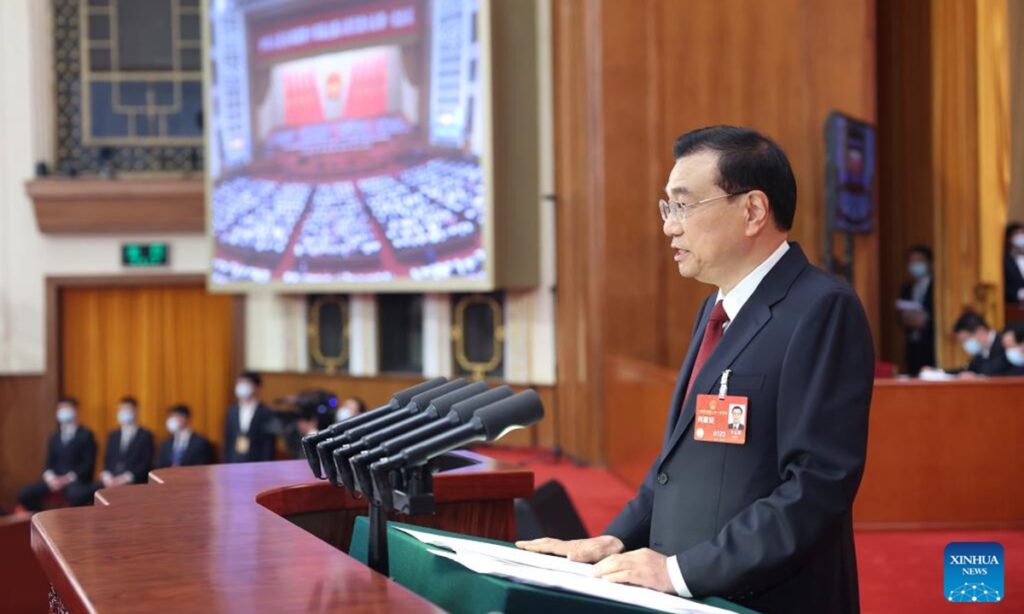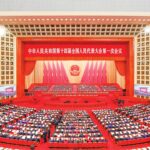China sets its GDP growth target for 2023 at around 5 percent. We should enhance the intensity and effectiveness of our proactive fiscal policy. We should do more to implement a prudent monetary policy in a targeted way. Social policies should meet basic living needs… In the Government Work Report delivered by Premier Li Keqiang on March 5, a series of key targets and policy directions have provided an important window for observing China’s future development. In particular, the economic growth target of around 5 percent has sparked heated discussions both domestically and internationally.
It is worth noting that the international community generally believes that the 5 percent target is “moderate,” “gentle,” and “cautious.” In other words, it is lower than the expected target from the outside world. Previously, international organizations such as the International Monetary Fund, and the domestic economic community had expected China’s GDP growth rate in 2023 to be around 5 percent or even higher. This to some extent shows that both within and outside China, there is optimism about China’s economic trend in 2023, which is a good phenomenon.
In fact, 5 percent is not low. China’s GDP in 2022 has already reached a high of 121 trillion yuan, and 5 percent is equivalent to 6 trillion yuan, which is an increase exceeding the GDP of most countries in the world. Looking at the international institutions’ expectations for global economic growth in 2023, it is approximately between 2.7 percent and 2.9 percent. It can be seen that the overall situation globally is not good. The US’ economic growth is projected at only 0.5 percent, Germany’s 0.2 percent, and the UK economy will contract by 0.6 percent. China’s 5 percent growth is still the strongest growth engine.
The Government Work Report also summarized the work of the past year and the past five years. GDP growth in 2022 was 3 percent, and the average annual GDP growth in the past five years was 5.2 percent. China’s GDP has reached $121 trillion yuan. When reporting on this, the media almost always used the words “extremely unusual” and “extraordinary.” In the past few years, China has faced many challenges that exceeded expectations. Under the strong leadership of the Party Central Committee with Comrade Xi Jinping at its core, we have united, strived to overcome difficulties and reached an achievement that is not easily obtained, demonstrating the great resilience of the Chinese economy.
Entering 2023, this great resilience and vitality have been further released. The healthy rebound of the Chinese economy has significantly increased the confidence of the outside world in the Chinese economy, and their expectations for the Chinese economy are also rising. Data released on March 1 showed that China’s Manufacturing Purchasing Managers’ Index (PMI) hit an 11-year high in February, and economic activities are rapidly rebounding. For a country as large as China to maintain steady development for so many years, this poses the most critical test to the country’s governance ability. It should be said that the steady leadership of those who steer the country is the key to China’s stable and long-term economic development. The 5 percent target is practical and leaves room for “various risks and uncertainties that future economic growth may face.”
The Government Work Report has set other development targets for this year, such as creating around 12 million new urban jobs, keeping the urban surveyed unemployment rate of around 5.5 percent, and targeting increase in consumer price index (CPI) of around 3 percent. Along with the economic growth target of 5 percent, they constitute the essence of China’s high-quality development centered on the people. It is worth emphasizing that these targets are achievable and reflect China’s rational and pragmatic development attitude. At the same time, if we do not work hard to achieve these targets, we will not reap the fruits. These tasks are not easy, and China’s entire society needs to continue to work hard and steadily move forward.
Every year has its own set of complex issues, but they cannot create major waves in front of China. Many previous risks and challenges have ultimately been transformed into concrete breakthroughs in China’s reform. The evolution of hot topics during the annual two sessions can clearly reflect this. For example, concerns about environmental pollution once caused widespread anxiety about China’s past development model, but they have served as greater driving force for the historic reform of transitioning to new growth drivers. The rapid development of the new energy industry, as well as the increase in the number of blue sky days, have become new highlights of China’s economic transformation. China’s institutional advantage of concentrating efforts to accomplish major tasks, the government’s rich experience and ability to use different policy tools for macro-control, and so on, have all been tested, consolidated, and strengthened during China’s progress, continuing to exert a deep and lasting impact.
Among the major economies in the world, China’s certainty is particularly outstanding and becoming a key driving force for global economic recovery. Despite the many difficulties and challenges ahead, the overall mentality of the Chinese society is firm and confident on the path forward. The Communist Party of China has led and united the Chinese people to continuously strive for a better life, which is the deep-seated driving force and source of confidence behind China’s stability and progress. This year’s two sessions will see a change in the government’s leadership. Unlike in Western countries, this will not mean a policy “U-turn.” Instead, it will open a new chapter in a great relay race, where the next leg of the journey will continue with unrelenting effort.
(Global Times)




